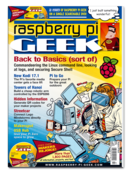Getting to know the Raspberry Pi I2C bus
Users rely on the very efficient GPIO interface of the Raspberry Pi for many types of hardware projects. However, some functions, such as analog input and output, are generally not supported by the GPIO and therefore are incorporated in Rasp Pi projects in a limited fashion – if at all.
Similarly, the Raspberry Pi's one lone PWM outlet can quickly put the brakes on a project. Software solutions like ServoBlaster [1] offer a convenient fix, although they are restricted in terms of usefulness. If you really need more digital I/O, though, you will quickly run up against hard limits.
The I2C bus is a simple and professional solution for projects of large scope, and the Raspberry Pi has two corresponding interfaces on-board. In a series of articles, I discuss a number of semiconductors, each of which has an interface for the I2C bus.
[...]
Buy this article as PDF
Pages: 6
(incl. VAT)







